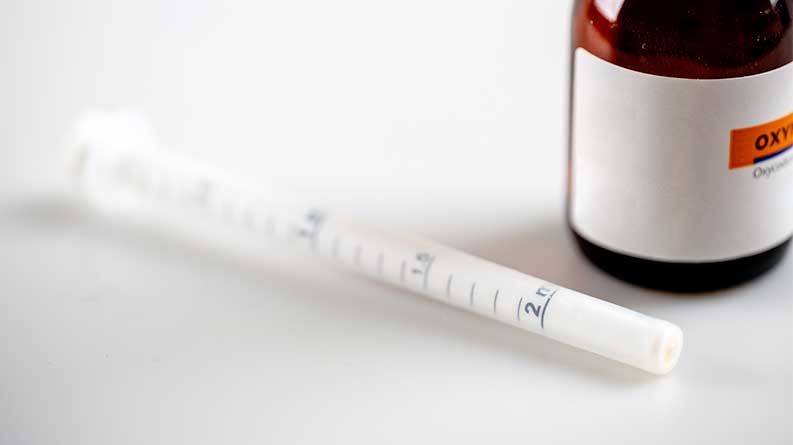Can You Inject Reformulated OxyContin?

Medically Reviewed By: Manish Mishra, MBBS
Abuse-deterrent OxyContin can prevent OxyContin tablets from being crushed, dissolved in a solution, and injected. Some studies suggest that OxyContin has seen lower rates of drug abuse due to the reformulation. However, other studies suggest the opposite.

No, you cannot inject OxyContin as a form of opioid abuse. Attempting to inject OxyContin can result in reduced effects of the drug, along with other serious health effects.
OxyContin is a prescription opioid drug with a long history of legal and illegal use. Its main ingredient, oxycodone hydrochloride, had a high potential for drug abuse until 2010, when the U.S. Food and Drug Administration approved an abuse-deterrent formulation of the drug.
While oxycodone may still have a high abuse potential, the existence of new extended-release and immediate-release OxyContin may reduce your risk of long-term health effects. Taking OxyContin as directed by your doctor can help with your pain relief and overall health.
OxyContin Vs. Reformulated OxyContin
OxyContin was a significant part of the opioid epidemic from the mid-1990s to the mid-2000s, seeing heavy use in both prescription sales and illicit drug use.
OxyContin was abused through more than one route of administration, including insufflation (snorting), plugging (rectal use), smoking, and intravenous use (injection).
Abuse-Deterrent OxyContin
To reduce the risk of an OxyContin overdose through unapproved methods of administration, the FDA and Purdue Pharma approved an abuse-deterrent formulation of OxyContin in 2010. This version prevented OxyContin tablets from being easily crushed, dissolved into a solution, or injected.
After the new abuse-deterrent formulation of OxyContin was released, there was a noticeable decline in physicians legally prescribing OxyContin.
The average amount of OxyContin prescribed per patient also decreased between 2010 and 2020. More patients switched to other forms of legal opioid use, such as oxymorphone or hydrocodone.
Consequences Of Abuse-Deterrent OxyContin
A 2020 report from the FDA suggested that patterns of OxyContin abuse, such as doctor shopping and illegal Oxy distribution, declined after the new formulation was introduced.
However, additional studies suggest other forms of opiate and painkiller abuse saw higher rates in the same time period:
- A 2022 study from the Clinical Journal of Pain reported a weak correlation between abuse-deterrent OxyContin formulations and lower rates of drug overdose.
- A 2019 study from the RAND Corporation reported higher rates of illicit heroin injection and rates of hepatitis C, suggesting people who could not access illicit oxycodone turned to illegal opioid analgesics instead.
Despite a wide range of data on the societal effects of abuse-deterrent OxyContin, the drug may be safer than before when taken properly. Ingestion of OxyContin according to your doctor can reduce the chances of resorting to illicit pain reliever substance abuse.
Risks & Dangers Of Injecting OxyContin
Abuse-deterrent OxyContin formulations were introduced to prevent serious health risks that can come from injecting prescription drugs, such as drug overdose and physical health effects.
Physical Health Risks
Injecting drugs can place high stress on the injection site. Severe side effects such as infections, abscesses, and wound botulism can occur when injecting OxyContin. Sharing needles to inject drugs can also increase your risk of blood-borne pathogens, such as HIV or hepatitis.
Opioid Overdose
Illicit oxycodone formulations can contain other harmful substances, such as fentanyl. Injecting high amounts of illicit drugs into your system can increase your risk of an opioid overdose.
Signs of an opioid overdose may include trouble breathing, loss of consciousness, and clammy skin. Call for medical help immediately if you see these signs in yourself or a loved one.
To learn about our opioid abuse treatment options, please contact Ohio Recovery Center today.
- The Clinical Journal of Pain — An Evaluation of the Effect of the OxyContin Reformulation https://journals.lww.com/clinicalpain/Fulltext/2022/06000/An_Evaluation_of_the_Effect_of_the_OxyContin.3.aspx
- Food and Drug Administration — Literature Review: Impact of Reformulated OxyContin on Abuse and Opioid-related Morbidity and Mortality https://www.fda.gov/media/141974/download
- Food and Drug Administration — Oxycontin HCl Label https://www.accessdata.fda.gov/drugsatfda_docs/label/2008/020553s059lbl.pdf
- StatNews — Study: ‘Abuse-deterrent’ OxyContin switch helped drive a hepatitis C spike https://www.statnews.com/2019/02/04/purdue-abuse-deterrent-oxycontin-hepatitis-c-infections/

